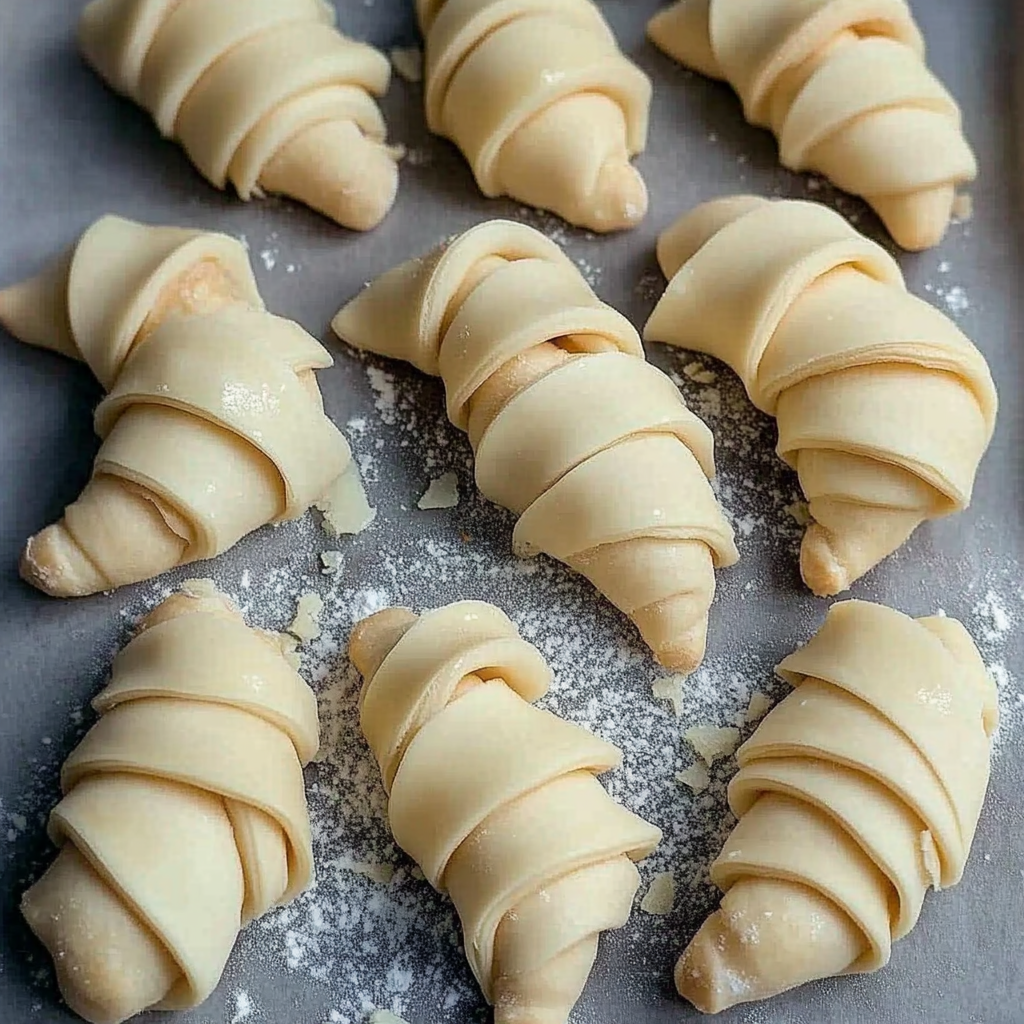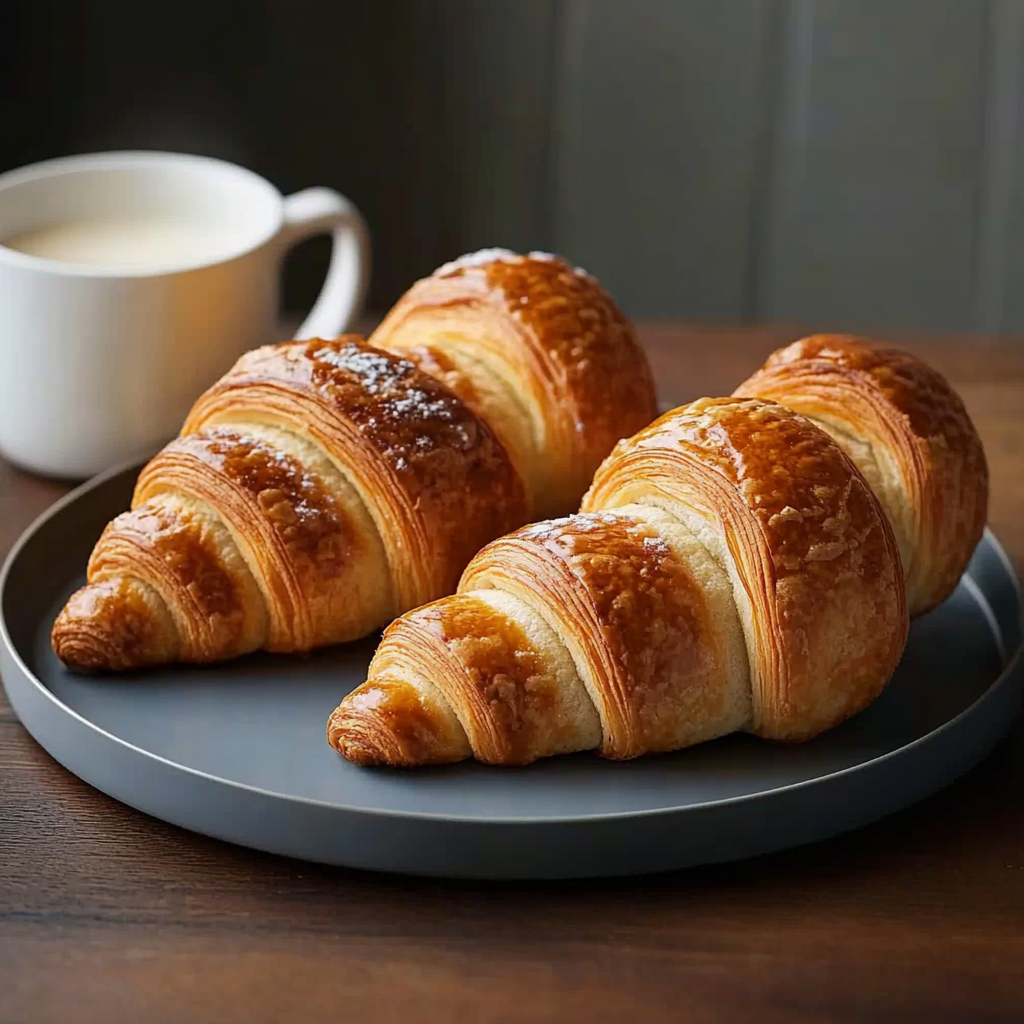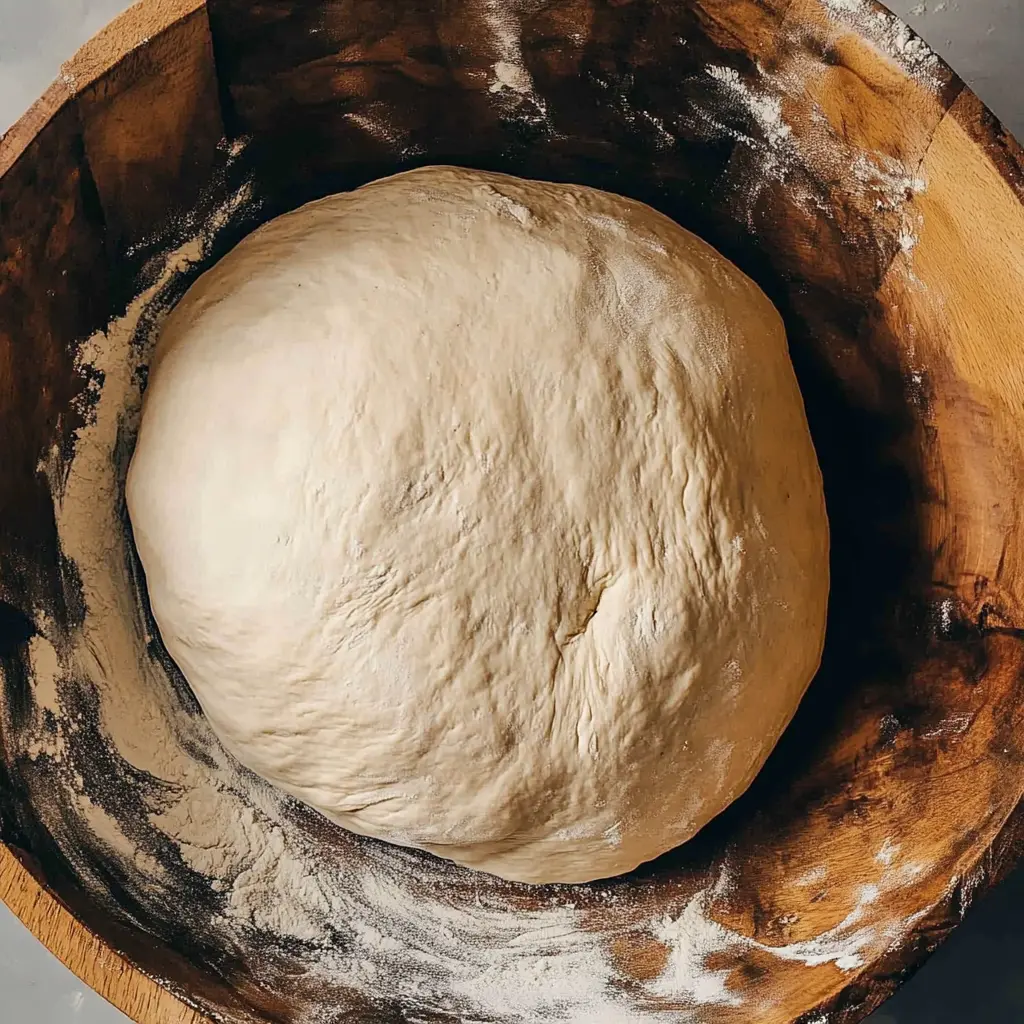Oh, almond croissants—those golden, flaky pillows of buttery bliss stuffed with sweet almond goodness. If you’ve ever strolled past a Swiss bakery, chances are you’ve been drawn in by their heavenly aroma and perfect dusting of powdered sugar. But what makes these pastries so special? And how are they different from their buttery cousin, the classic croissant, or even the nutty Swiss favorite, Nussgipfel? Let’s dive headfirst into the story behind this delicious Swiss treat, its rich cultural roots, and—because who wants to just read about pastries?—how you can whip up your own batch of almondy perfection at home.
In This Guide
What is a Mandelgipfel?
The Mandelgipfel, an almond-filled Swiss pastry, is similar to a croissant but with a delightful twist. Featuring a rich almond paste inside its crescent-shaped dough, this pastry is loved for its buttery layers and subtle nutty flavor. Commonly found in Swiss bakeries and especially enjoyed at breakfast, it’s a flaky, slightly sweet treat that pairs perfectly with coffee or tea.
In Swiss breakfast culture, the Mandelgipfel holds a special place. While croissants may be more famous globally, the Mandelgipfel’s distinctive almond filling sets it apart. Whether you grab one from a bakery on your way to work or bake it fresh at home, it’s sure to become a favorite. Even better, you don’t need to travel to Switzerland to enjoy it! We’ll guide you through making your own Mandelgipfel, bringing the flavors of Swiss pastries right into your kitchen.
A Look into Swiss Pastries: Where Does Mandelgipfel Fit In?
Switzerland offers a rich variety of pastries, each reflecting the country’s regional diversity and commitment to high-quality ingredients. Among them, you’ll find Gipfeli (Swiss croissants), Nussgipfel (hazelnut croissants), and the almond-filled Mandelgipfel, which are some of the most beloved treats in Swiss bakeries.
Gipfeli, Switzerland’s take on the French croissant, shares the same crescent shape but is generally a little less buttery and slightly sweeter. The Mandelgipfel builds on this foundation, adding a delicious almond filling that makes it truly unique. If you’re curious how the Mandelgipfel compares to its hazelnut-filled cousin, the Nussgipfel, be sure to check out the Difference between Mandelgipfel and Nussgipfel.
The History of Mandelgipfel: A Swiss Delight
Like many European pastries, the Mandelgipfel traces its origins back to the Austrian kipferl, a crescent-shaped pastry that was the precursor to the modern croissant. As these pastries spread into Switzerland, local bakers made their own adaptations, transforming them into the Gipfeli we know today. While the French perfected the buttery, layered croissant, Swiss bakers developed their own versions, combining traditional techniques with local flavors to create specialties like the Mandelgipfel.
This almond-flavored delicacy captures Switzerland’s love for rich yet elegant desserts. By using the croissant’s signature laminated dough and adding a delicious almond paste filling, Swiss bakers turned it into a beloved breakfast or snack enjoyed across the country. Over time, the Mandelgipfel has become a hallmark of Swiss pastries, offering a perfect balance of flaky dough and nutty sweetness, proudly standing alongside other Viennoiserie classics.
If you’re looking to explore authentic Swiss recipes for this almond treat, here’s a great resource for the Traditional Mandelgipfel recipe.
Ingredients for Making Mandelgipfel at Home
Before we dive into the steps, let’s gather all the ingredients you’ll need. The great thing about making Mandelgipfel is that, while they look fancy, the ingredients are simple and easy to find. Here’s everything required for your homemade almond croissant:
Essential Ingredients:
Puff pastry (store-bought or homemade)Almond paste (made from ground almonds, sugar, butter, and almond extract)Butter (for laminating the dough and mixing into the almond filling)Sugar (to sweeten the almond filling and add a touch to the dough)Eggs (for the almond filling and brushing the pastry to achieve a golden finish)Flour (only if you’re making the dough from scratch)Milk (to bring the dough together and create the perfect consistency)
Choosing fresh, high-quality ingredients is crucial to ensure your Mandelgipfel comes out perfectly flaky, with a rich, nutty flavor. With the right ingredients, this Swiss pastry will not only look amazing but taste delicious!
Step-by-Step Guide: How to Make Mandelgipfel at Home
Now, here comes the fun part! Let’s walk through the steps to make your very own Mandelgipfel at home. The process involves a few important stages, from preparing the dough to shaping and baking your almond-filled crescents. Trust me, the result is totally worth the effort! Let’s get started!
Step 1: Preparing the Dough
If you’re using store-bought puff pastry, you’re already halfway done! However, if you’re up for a challenge and want to make your own dough from scratch, follow these simple steps:
First, mix the dry ingredients: In a mixing bowl, combine flour, yeast, sugar, and salt.
Next, add the wet ingredients: Gradually incorporate cold butter and milk, kneading the mixture until the dough becomes smooth and elastic.
Then, create the layers: Once the dough is ready, roll it out into a large rectangle. Place cold butter in the center, fold the dough over the butter, and roll it out again. Repeat this process several times.
Finally, for the laminating process, the secret to achieving those flaky layers is in folding and chilling the dough multiple times. Each fold traps layers of butter within the dough, which creates that deliciously light and crisp texture during baking.
With a bit of patience, you’ll master this laminating technique, ensuring your Mandelgipfel comes out beautifully flaky!
Step 2: Making the Almond Paste Filling
The almond filling is the heart of the Mandelgipfel, and it’s surprisingly easy to make. You’ll need:
- 200g ground almonds
- 100g butter (softened)
- 100g sugar
- 1 tsp almond extract
- A small amount of milk to adjust consistency.
Simply mix all the ingredients in a bowl until you get a smooth paste. The result? A sweet almond filling that’s rich but not too overwhelming.
Step 3: Laminating the Dough for Flaky Layers
Here’s where you’ll create those signature flaky layers:
First, roll out your dough and place your butter in the center.
Next, fold the dough over the butter and roll it out again.
Then, repeat this process at least three times, making sure that each layer is thin and even. This lamination process is essential for achieving the light, flaky texture that defines your Mandelgipfel.
Step 4: Shaping the Mandelgipfel
Once your dough is ready, next it’s time to shape the Mandelgipfel:
First, roll the dough out into a large rectangle and cut it into triangles.
Then, place a spoonful of the almond filling at the base of each triangle.
Finally, roll the dough from the base to form a crescent shape. Make sure the almond paste is evenly distributed for that perfect bite.

Step 5: Baking to Perfection
Preheat your oven to 375°F (190°C). Next, brush each Mandelgipfel with an egg wash to give them a beautiful golden color. After that, bake for 15-20 minutes, or until the pastry puffs up and turns golden brown.
As they bake, the warm, nutty aroma of these freshly made Swiss almond pastries will fill your kitchen. You’ll know they’re ready when they are lightly browned on top and feel perfectly flaky to the touch.
Customization Options for Mandelgipfel
The classic Mandelgipfel is delicious on its own, but why not add a twist? Here are some fun ways to customize your almond croissants:
- Add a touch of chocolate: Mix chocolate chips into the almond filling or drizzle melted chocolate on top for a truly indulgent treat.
- Try savory variations: For a unique twist, fill the pastry with cheese or ham to create a savory breakfast option.
- Nutella Mandelgipfel: Replace the almond filling with Nutella for a rich, chocolatey version that’s irresistibly decadent.
Looking for more croissant variations? Check out our Authentic Gipfeli Recipe for breakfast for even more delicious ideas!
Serving Suggestions: How to Enjoy Mandelgipfel
The best way to enjoy this almond-filled pastry? Definitely fresh out of the oven! Here are a few serving ideas:
- With coffee: A hot cup of coffee or espresso perfectly complements the rich almond flavor.
- Swiss tea or hot chocolate: For a more authentic experience, pair it with Swiss tea or a rich, creamy hot chocolate.
- As part of a Swiss-inspired brunch: For a complete meal, serve it alongside other Swiss pastries, cheeses, and fruits for a delightful brunch spread. Additionally, you can check out our Hearty breakfast ideas for more inspiration to complement your almond croissant.

Storing and Reheating Tips
Mandelgipfel is best enjoyed fresh, but you can still savor them later by following these storage tips:
- At room temperature: Store in an airtight container for up to two days to maintain freshness.
- Freezing: Mandelgipfel can be frozen for up to a month. When you’re ready to enjoy them, simply thaw and reheat in the oven at 300°F (150°C) for about 10 minutes to restore their flakiness.
The Difference Between Mandelgipfel and Other Swiss Pastries
Wondering how Mandelgipfel compares to other pastries like Nussgipfel and Gipfeli?
- Mandelgipfel vs. Nussgipfel: The key difference is in the filling—Mandelgipfel is filled with almond paste, while Nussgipfel is made with hazelnuts or other nuts. Both are delicious, but almond lovers will gravitate toward Mandelgipfel, while those who prefer a richer, nuttier flavor might opt for Nussgipfel.
To explore more about Swiss pastry varieties, check out the Difference between Mandelgipfel and Nussgipfel.
Why Mandelgipfel is the Perfect Swiss Breakfast Treat
What makes the Mandelgipfel such a perfect breakfast choice? It offers the ideal balance between lightness and indulgence. The sweetness of the almond paste blends perfectly with the flaky, buttery layers, creating a pastry that’s rich but not too heavy. This makes it an excellent option for busy mornings, a leisurely weekend brunch, or even a mid-morning snack with coffee.
Whether you’re a busy parent, a home cook, or someone who simply loves baking, the Mandelgipfel is a delightful Swiss breakfast pastry that’s not only delicious but also surprisingly easy to make at home.
Traditional Mandelgipfel Recipe: Following Swiss Baking Techniques
When making Mandelgipfel at home, it’s helpful to follow traditional Swiss baking techniques for the best results. Authentic Mandelgipfel recipes often call for puff pastry, almond paste, and careful attention to the dough-folding process to achieve those flaky layers.
For more on the Swiss approach to this classic pastry, you can visit the Traditional Mandelgipfel recipe, which offers step-by-step guidance.
Swiss Almond Pastry: A Symbol of Swiss Confectionery
Mandelgipfel is more than just a pastry—it’s a true symbol of Swiss confectionery craftsmanship. From the precise techniques used in making the dough to the high-quality almond paste filling, every bite showcases the care and passion that Swiss bakers pour into their work.
For a deeper dive into Swiss Bake Mandelgipfel specialties, check out this comprehensive guide to Swiss almond pastries and specialties: Swiss Bake Mandelgipfel specialties.
Tips for Baking Mandelgipfel at Home
Baking Mandelgipfel at home can be a rewarding challenge. Here are a few insider tips to ensure success:
- Use cold butter: Cold butter is key to achieving those perfect flaky layers. Be sure it’s well chilled when laminating the dough.
- Don’t overfill: Although it’s tempting to add extra almond filling, overfilling may cause the pastry to break open while baking.
- Be patient: Allow the dough enough time to rest and chill between steps. This patience will result in beautifully layered, light pastries.
How to Incorporate Mandelgipfel into Your Everyday Meals
Mandelgipfel isn’t just limited to breakfast! Here are a few fun ways to enjoy it throughout the day:
- Snack time: Treat yourself to a Mandelgipfel in the afternoon, paired with a cup of tea or coffee.
- Brunch spread: Add it to a brunch spread alongside fruits, cheeses, and jams for a sweet and savory combo.
- Dessert option: Serve as a light dessert with a scoop of vanilla ice cream or drizzle with chocolate sauce for an extra indulgence.
Conclusion: Mastering the Mandelgipfel
Now that you know all about the Mandelgipfel, why not give it a try at home? This delicious pastry is sure to impress your family and friends, while offering a true taste of Swiss food culture. Whether you enjoy it fresh from the oven or paired with your morning coffee, this almond-filled croissant is the perfect way to start your day.
With a little practice, you’ll soon master the art of making Mandelgipfel, bringing the flavors of a Swiss bakery right into your kitchen. Be sure to explore Kai Recipes for more breakfast ideas and inspiration!

FAQs
1. What makes Mandelgipfel different from a regular croissant?
Mandelgipfel is filled with almond paste, giving it a sweet, nutty flavor that sets it apart from the plain, buttery croissant.
2. Can I make Mandelgipfel with store-bought puff pastry?
Absolutely! Store-bought puff pastry saves time and still delivers great results. Just make sure to get high-quality puff pastry for the best flakiness.
3. Is Mandelgipfel gluten-free?
Traditionally, no. Mandelgipfel is made with regular wheat-based puff pastry. However, if needed, you can try using gluten-free puff pastry alternatives to accommodate dietary restrictions.
4. How do I make the almond filling less sweet?
To reduce the sweetness, you can simply cut back on the sugar or balance the almond paste by adding a pinch of salt or a bit of lemon zest for extra depth and flavor.
5. Where can I find authentic Mandelgipfel in Switzerland?
You can find Mandelgipfel at most Swiss bakeries, but for a guide to authentic places, check out the Authentic Swiss Mandelgipfel guide.

What is a Mandelgipfel? Discover the Irresistible Almond Croissant Recipe
- Total Time: 50 minutes
- Yield: 10 Gipfeli 1x
- Diet: Vegetarian
Description
You’re going to love this one—golden, flaky, and irresistibly buttery, these homemade Gipfeli (aka Swiss croissants) are what breakfast dreams are made of! Think tender, melt-in-your-mouth layers, a crisp golden crust, and just the right balance of richness and airiness. The best part? You can fill them with almond paste, Nutella, or keep them classic! Whether you’re enjoying them fresh out of the oven with a cup of coffee or saving them for a delightful snack later, these Gipfeli are pure bakery-style perfection—but made right in your own kitchen!
Ingredients
🥖 For the Dough:
- 500g all-purpose flour
- 2 tbsp active dry yeast
- 250g cold butter, cubed
- 250ml warm milk (helps activate the yeast!)
- 50g sugar
🥐 Optional Fillings:
- Almond paste (for a classic Mandelgipfel!)
- Nutella (because chocolate makes everything better!)
🥚 For the Egg Wash:
- 1 egg, beaten
- 1 tbsp water (for that perfect golden shine)
Instructions
1. Make the Dough
- Grab a large mixing bowl and whisk together flour, yeast, and a pinch of salt.
- Make a well in the center and pour in warm milk and sugar. Stir gently to start activating the yeast.
- Using your hands or a mixer with a dough hook, mix until a rough dough forms.
2. Work in the Butter
- Add in your cold butter cubes and start kneading. You’ll notice chunks of butter throughout the dough—this is what makes the layers SO GOOD!
- Knead on a lightly floured surface for about 10 minutes, until smooth and elastic.
3. Let the Dough Rest
- Place the dough in a lightly oiled bowl, cover with plastic wrap, and let it rise for 1-2 hours (or until doubled in size).
- This step is crucial—it’s where all the magic of fluffiness happens!
4. Time to Laminate! (Layer the Butter)
- Roll out the dough into a large rectangle, about three times as long as it is wide.
- Spread softened butter over two-thirds of the rectangle (yes, more butter = more delicious layers!).
- Fold the dough like a letter:
- Bring the bottom non-buttered third up over the middle.
- Fold the top third down over that.
- Wrap in plastic and chill for 30 minutes (this keeps the butter from melting too soon!).
5. Roll, Fold, Repeat
- Take the chilled dough and roll it into another rectangle.
- Repeat the letter fold, wrap, and chill again for another 30 minutes.
- Do this three times to build up those dreamy layers!
6. Shape the Gipfeli
- Roll the dough out to 5mm thickness.
- Cut into long, narrow triangles using a sharp knife or pizza cutter.
- If adding a filling, spread a little almond paste or Nutella near the wide end.
- Roll each triangle from the wide base to the tip, forming a crescent shape.
- Place on a lined baking sheet, tip side down (so they don’t unroll while baking).
7. Egg Wash & Bake
- Brush each Gipfeli with egg wash—this is the secret to that beautiful golden-brown shine!
- Bake in a preheated oven at 190°C (375°F) for 15-20 minutes, until beautifully golden and flaky.
8. Enjoy!
- Let them cool for a few minutes (if you can resist!).
- Dust with powdered sugar or drizzle with melted chocolate for extra indulgence.
Notes
- 🥐 Make-Ahead Tip: You can freeze unbaked Gipfeli and bake them fresh anytime—just pop them in the oven straight from the freezer!
- 🥖 Traditional Touch: If you want an extra-crisp crust, spritz some water into the oven when you put them in.
- 🍫 Sweet or Savory? Keep them plain, fill with Nutella, or go savory with cheese & ham!
- Prep Time: 30 minutes
- Cook Time: 20 minutes
- Category: Breakfast
- Method: Baking
- Cuisine: French, German
Nutrition
- Serving Size: 1 Gipfeli
- Calories: 320 kcal
- Sugar: 4g
- Sodium: 250mg
- Fat: 17g
- Saturated Fat: 10g
- Unsaturated Fat: 6g
- Trans Fat: 0g
- Carbohydrates: 35g
- Fiber: 2g
- Protein: 6g
- Cholesterol: 40mg

